Published On:Friday, 6 January 2012
Posted by Muhammad Atif Saeed
Lesson 1: Entering Text and Numbers
The Microsoft Excel Window
Microsoft Excel is an electronic spreadsheet. You can use it to organize your data into rows and columns. You can also use it to perform mathematical calculations quickly. This tutorial teaches Microsoft Excel basics. Although knowledge of how to navigate in a Windows environment is helpful, this tutorial was created for the computer novice.
This lesson will introduce you to the Excel window. You use the window to interact with Excel. To begin this lesson, start Microsoft Excel 2007. The Microsoft Excel window appears and your screen looks similar to the one shown here.
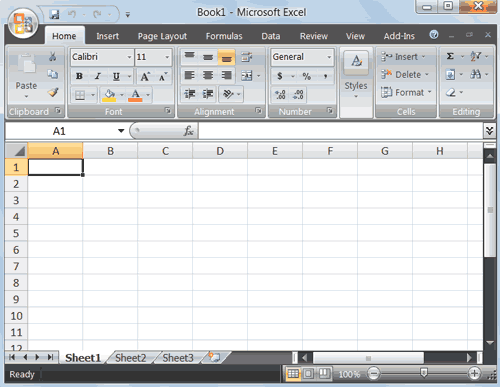
Note: Your screen will probably not look exactly like the screen shown. In Excel 2007, how a window displays depends on the size of your window, the size of your monitor, and the resolution to which your monitor is set. Resolution determines how much information your computer monitor can display. If you use a low resolution, less information fits on your screen, but the size of your text and images are larger. If you use a high resolution, more information fits on your screen, but the size of the text and images are smaller. Also, settings in Excel 2007, Windows Vista, and Windows XP allow you to change the color and style of your windows.
The Microsoft Office Button
In the upper-left corner of the Excel 2007 window is the Microsoft Office button. When you click the button, a menu appears. You can use the menu to create a new file, open an existing file, save a file, and perform many other tasks.
The Quick Access Toolbar
Next to the Microsoft Office button is the Quick Access toolbar. The Quick Access toolbar gives you with access to commands you frequently use. By default, Save, Undo, and Redo appear on the Quick Access toolbar. You can use Save to save your file, Undo to roll back an action you have taken, and Redo to reapply an action you have rolled back.
The Title Bar
Next to the Quick Access toolbar is the Title bar. On the Title bar, Microsoft Excel displays the name of the workbook you are currently using. At the top of the Excel window, you should see "Microsoft Excel - Book1" or a similar name.
The Ribbon
You use commands to tell Microsoft Excel what to do. In Microsoft Excel 2007, you use the Ribbon to issue commands. The Ribbon is located near the top of the Excel window, below the Quick Access toolbar. At the top of the Ribbon are several tabs; clicking a tab displays several related command groups. Within each group are related command buttons. You click buttons to issue commands or to access menus and dialog boxes. You may also find a dialog box launcher in the bottom-right corner of a group. When you click the dialog box launcher, a dialog box makes additional commands available.
Worksheets
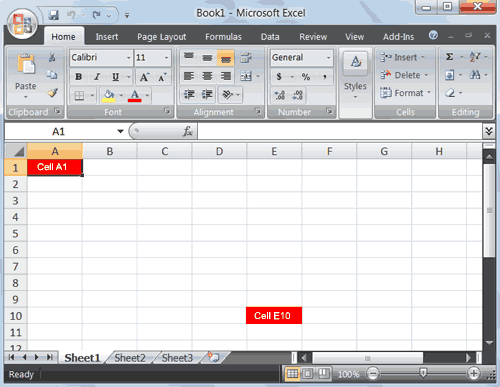
Microsoft Excel consists of worksheets. Each worksheet contains columns and rows. The columns are lettered A to Z and then continuing with AA, AB, AC and so on; the rows are numbered 1 to 1,048,576. The number of columns and rows you can have in a worksheet is limited by your computer memory and your system resources.
The combination of a column coordinate and a row coordinate make up a cell address. For example, the cell located in the upper-left corner of the worksheet is cell A1, meaning column A, row 1. Cell E10 is located under column E on row 10. You enter your data into the cells on the worksheet.
The Formula Bar
Formula Bar
If the Formula bar is turned on, the cell address of the cell you are in displays in the Name box which is located on the left side of the Formula bar. Cell entries display on the right side of the Formula bar. If you do not see the Formula bar in your window, perform the following steps:
- Choose the View tab.
- Click Formula Bar in the Show/Hide group. The Formula bar appears.
Note: The current cell address displays on the left side of the Formula bar.
The Status Bar
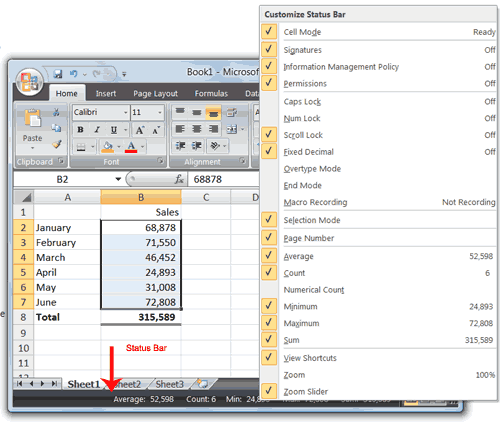
The Status bar appears at the very bottom of the Excel window and provides such information as the sum, average, minimum, and maximum value of selected numbers. You can change what displays on the Status bar by right-clicking on the Status bar and selecting the options you want from the Customize Status Bar menu. You click a menu item to select it. You click it again to deselect it. A check mark next to an item means the item is selected.
Move Around a Worksheet
By using the arrow keys, you can move around your worksheet. You can use the down arrow key to move downward one cell at a time. You can use the up arrow key to move upward one cell at a time. You can use the Tab key to move across the page to the right, one cell at a time. You can hold down the Shift key and then press the Tab key to move to the left, one cell at a time. You can use the right and left arrow keys to move right or left one cell at a time. The Page Up and Page Down keys move up and down one page at a time. If you hold down the Ctrl key and then press the Home key, you move to the beginning of the worksheet.
EXERCISE 1
Move Around the Worksheet
The Down Arrow Key
- Press the down arrow key several times. Note that the cursor moves downward one cell at a time.
The Up Arrow Key
- Press the up arrow key several times. Note that the cursor moves upward one cell at a time.
The Tab Key
- Move to cell A1.
- Press the Tab key several times. Note that the cursor moves to the right one cell at a time.
The Shift+Tab Keys
- Hold down the Shift key and then press Tab. Note that the cursor moves to the left one cell at a time.
The Right and Left Arrow Keys
- Press the right arrow key several times. Note that the cursor moves to the right.
- Press the left arrow key several times. Note that the cursor moves to the left.
Page Up and Page Down
- Press the Page Down key. Note that the cursor moves down one page.
- Press the Page Up key. Note that the cursor moves up one page.
The Ctrl-Home Key
- Move the cursor to column J.
- Stay in column J and move the cursor to row 20.
- Hold down the Ctrl key while you press the Home key. Excel moves to cell A1.
Go To Cells Quickly
The following are shortcuts for moving quickly from one cell in a worksheet to a cell in a different part of the worksheet.
EXERCISE 2
Go to -- F5
The F5 function key is the "Go To" key. If you press the F5 key, you are prompted for the cell to which you wish to go. Enter the cell address, and the cursor jumps to that cell.
- Press F5. The Go To dialog box opens.
- Type J3 in the Reference field.
- Press Enter. Excel moves to cell J3.
Go to -- Ctrl+G
You can also use Ctrl+G to go to a specific cell.
- Hold down the Ctrl key while you press "g" (Ctrl+g). The Go To dialog box opens.
- Type C4 in the Reference field.
- Press Enter. Excel moves to cell C4.
The Name Box
You can also use the Name box to go to a specific cell. Just type the cell you want to go to in the Name box and then press Enter.
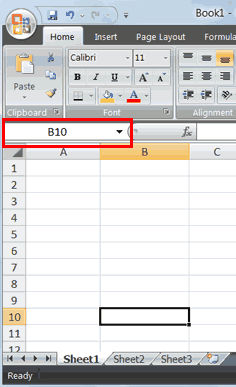
- Type B10 in the Name box.
- Press Enter. Excel moves to cell B10.
Select Cells
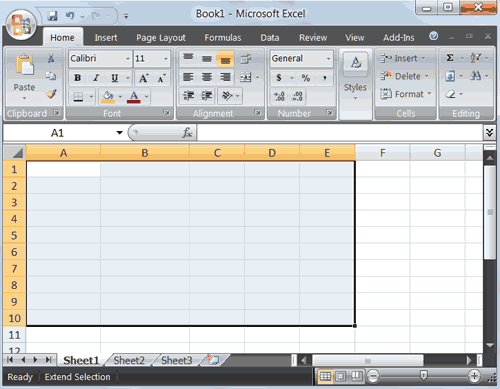
If you wish to perform a function on a group of cells, you must first select those cells by highlighting them. The exercises that follow teach you how to select.
EXERCISE 3
Select Cells
To select cells A1 to E1:
- Go to cell A1.
- Press the F8 key. This anchors the cursor.
- Note that "Extend Selection" appears on the Status bar in the lower-left corner of the window. You are in the Extend mode.
- Click in cell E7. Excel highlights cells A1 to E7.
- Press Esc and click anywhere on the worksheet to clear the highlighting.
Alternative Method: Select Cells by Dragging
You can also select an area by holding down the left mouse button and dragging the mouse over the area. In addition, you can select noncontiguous areas of the worksheet by doing the following:
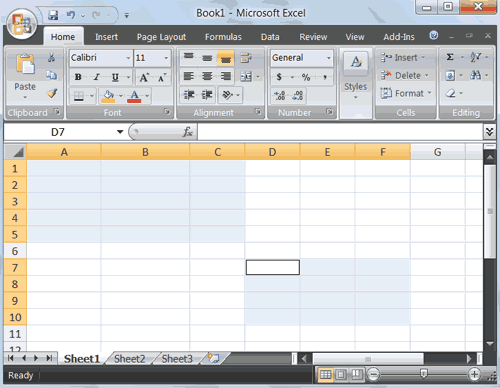
- Go to cell A1.
- Hold down the Ctrl key. You won't release it until step 9. Holding down the Ctrl key enables you to select noncontiguous areas of the worksheet.
- Press the left mouse button.
- While holding down the left mouse button, use the mouse to move from cell A1 to C5.
- Continue to hold down the Ctrl key, but release the left mouse button.
- Using the mouse, place the cursor in cell D7.
- Press the left mouse button.
- While holding down the left mouse button, move to cell F10. Release the left mouse button.
- Release the Ctrl key. Cells A1 to C5 and cells D7 to F10 are selected.
- Press Esc and click anywhere on the worksheet to remove the highlighting.
Enter Data
In this section, you will learn how to enter data into your worksheet. First, place the cursor in the cell in which you want to start entering data. Type some data, and then press Enter. If you need to delete, press the Backspace key to delete one character at a time.
EXERCISE 4
Enter Data
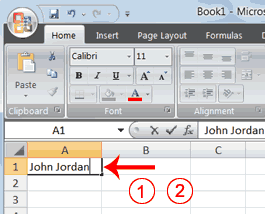
- Place the cursor in cell A1.
- Type John Jordan. Do not press Enter at this time.
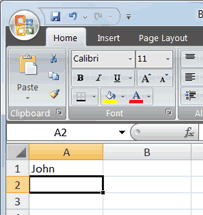
Delete Data
The Backspace key erases one character at a time.
- Press the Backspace key until Jordan is erased.
- Press Enter. The name "John" appears in cell A1.
Edit a Cell
After you enter data into a cell, you can edit the data by pressing F2 while you are in the cell you wish to edit.
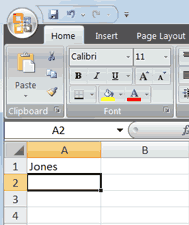
EXERCISE 5
Edit a Cell
Change "John" to "Jones."
- Move to cell A1.
- Press F2.
- Use the Backspace key to delete the "n" and the "h."
- Type nes.
- Press Enter.
Alternate Method: Editing a Cell by Using the Formula Bar
You can also edit the cell by using the Formula bar. You change "Jones" to "Joker" in the following exercise.
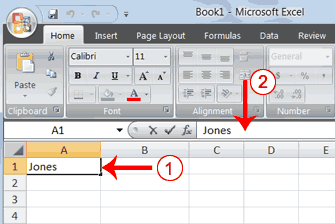
- Move the cursor to cell A1.
- Click in the formula area of the Formula bar.
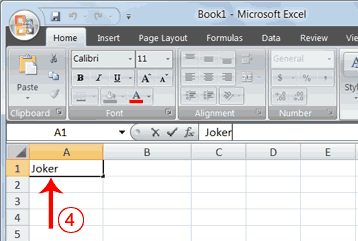
- Use the backspace key to erase the "s," "e," and "n."
- Type ker.
- Press Enter.
Alternate Method: Edit a Cell by Double-Clicking in the Cell
You can change "Joker" to "Johnson" as follows:
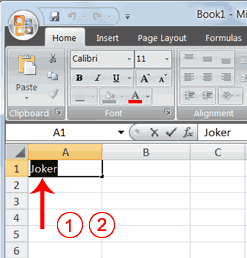
- Move to cell A1.
- Double-click in cell A1.
- Press the End key. Your cursor is now at the end of your text.
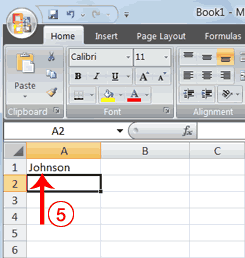
- Use the Backspace key to erase "r," "e," and "k."
- Type hnson.
- Press Enter.
Change a Cell Entry
Typing in a cell replaces the old cell entry with the new information you type.
- Move the cursor to cell A1.
- Type Cathy.
- Press Enter. The name "Cathy" replaces "Johnson."
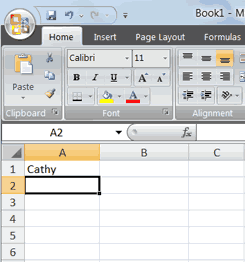
Wrap Text
When you type text that is too long to fit in the cell, the text overlaps the next cell. If you do not want it to overlap the next cell, you can wrap the text.
EXERCISE 6
Wrap Text
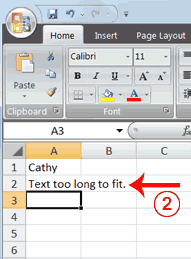
- Move to cell A2.
- Type Text too long to fit.
- Press Enter.
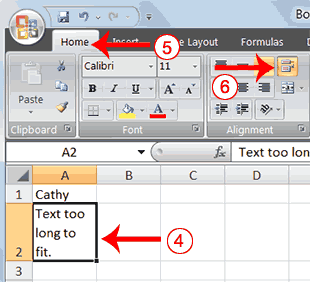
- Return to cell A2.
- Choose the Home tab.
- Click the Wrap Text button
 . Excel wraps the text in the cell.
. Excel wraps the text in the cell.
Delete a Cell Entry
To delete an entry in a cell or a group of cells, you place the cursor in the cell or select the group of cells and press Delete.
EXERCISE 7
Delete a Cell Entry
- Select cells A1 to A2.
- Press the Delete key.
Save a File
This is the end of Lesson1. To save your file:
- Click the Office button. A menu appears.
- Click Save. The Save As dialog box appears.
- Go to the directory in which you want to save your file.
- Type Lesson1 in the File Name field.
- Click Save. Excel saves your file.
Close Excel
Close Microsoft Excel.
- Click the Office button. A menu appears.
- Click Close. Excel closes.










